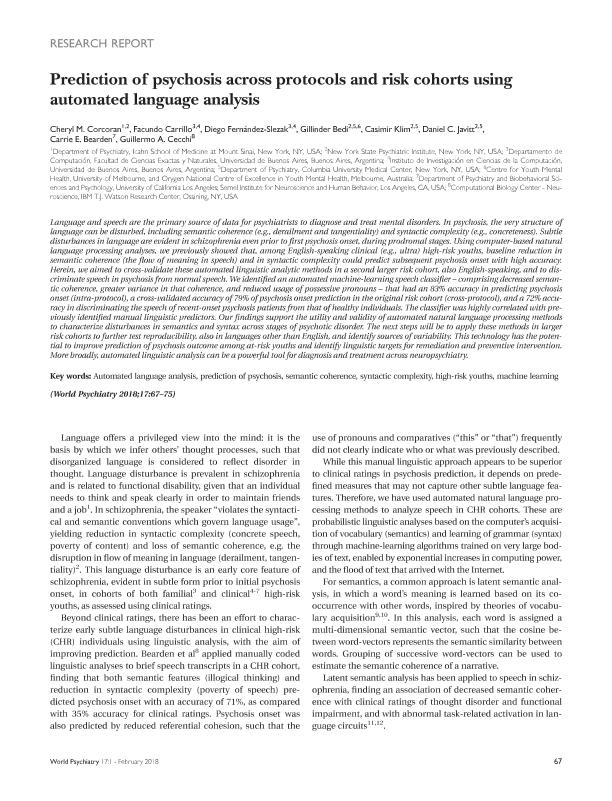Artículo
Prediction of psychosis across protocols and risk cohorts using automated language analysis
Corcoran, Cheryl M.; Carrillo, Facundo ; Fernandez Slezak, Diego
; Fernandez Slezak, Diego ; Bedi, Gillinder; Klim, Casimir; Javitt, Daniel C.; Bearden, Carrie E.; Cecchi, Guillermo Alberto
; Bedi, Gillinder; Klim, Casimir; Javitt, Daniel C.; Bearden, Carrie E.; Cecchi, Guillermo Alberto
 ; Fernandez Slezak, Diego
; Fernandez Slezak, Diego ; Bedi, Gillinder; Klim, Casimir; Javitt, Daniel C.; Bearden, Carrie E.; Cecchi, Guillermo Alberto
; Bedi, Gillinder; Klim, Casimir; Javitt, Daniel C.; Bearden, Carrie E.; Cecchi, Guillermo Alberto
Fecha de publicación:
02/2018
Editorial:
Wiley
Revista:
World Psychiatry
ISSN:
1723-8617
Idioma:
Inglés
Tipo de recurso:
Artículo publicado
Clasificación temática:
Resumen
Language and speech are the primary source of data for psychiatrists to diagnose and treat mental disorders. In psychosis, the very structure of language can be disturbed, including semantic coherence (e.g., derailment and tangentiality) and syntactic complexity (e.g., concreteness). Subtle disturbances in language are evident in schizophrenia even prior to first psychosis onset, during prodromal stages. Using computer-based natural language processing analyses, we previously showed that, among English-speaking clinical (e.g., ultra) high-risk youths, baseline reduction in semantic coherence (the flow of meaning in speech) and in syntactic complexity could predict subsequent psychosis onset with high accuracy. Herein, we aimed to cross-validate these automated linguistic analytic methods in a second larger risk cohort, also English-speaking, and to discriminate speech in psychosis from normal speech. We identified an automated machine-learning speech classifier – comprising decreased semantic coherence, greater variance in that coherence, and reduced usage of possessive pronouns – that had an 83% accuracy in predicting psychosis onset (intra-protocol), a cross-validated accuracy of 79% of psychosis onset prediction in the original risk cohort (cross-protocol), and a 72% accuracy in discriminating the speech of recent-onset psychosis patients from that of healthy individuals. The classifier was highly correlated with previously identified manual linguistic predictors. Our findings support the utility and validity of automated natural language processing methods to characterize disturbances in semantics and syntax across stages of psychotic disorder. The next steps will be to apply these methods in larger risk cohorts to further test reproducibility, also in languages other than English, and identify sources of variability. This technology has the potential to improve prediction of psychosis outcome among at-risk youths and identify linguistic targets for remediation and preventive intervention. More broadly, automated linguistic analysis can be a powerful tool for diagnosis and treatment across neuropsychiatry.
Archivos asociados
Licencia
Identificadores
Colecciones
Articulos(ICC)
Articulos de INSTITUTO DE INVESTIGACION EN CIENCIAS DE LA COMPUTACION
Articulos de INSTITUTO DE INVESTIGACION EN CIENCIAS DE LA COMPUTACION
Citación
Corcoran, Cheryl M.; Carrillo, Facundo; Fernandez Slezak, Diego; Bedi, Gillinder; Klim, Casimir; et al.; Prediction of psychosis across protocols and risk cohorts using automated language analysis; Wiley; World Psychiatry; 17; 1; 2-2018; 67-75
Compartir
Altmétricas



